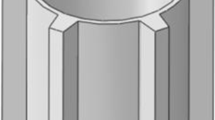Abstract
In order to avoid the highly complex process sequences and the potential instable metal flow in the manufacture of thin-walled metal circular rings with corrugated meridians, a forming method without use of axial compression on blank end is developed specially. A highly viscous polymer, i.e., the viscous medium, is utilized as pressure carrying medium in the proposed method. Since the lack of axial feeding leads to the insufficient metal flow into the die cavity, which finally causes severe wall thickness thinning, the tangential adhesive stress at blank/medium interface is used to promote metal flow. The limit of diameter variation of thin-walled metal circular rings produced by employing different types of viscous medium is predicted by finite element analysis (FEA) and resulting strain-based FLD. The numerical results show that employing viscous medium with proper strain rate sensitive exponent (m) will be feasible to extend the limit of diameter variation. Based on the evaluation on the achievable diameter variation in compression forming and expansion forming, a multistep forming process was presented. Accordingly, nickel-based superalloy parts with one and two convolutions were manufactured successfully. The end displacement of ring-shaped blank is considerable and the resulting wall thickness reduction is relatively small (9 %), which demonstrates the metal flow is promoted effectively. The proposed forming method is considered to be simple and convenient for the fabrication of ring-shaped parts with extremely thin wall and complex shapes.
Similar content being viewed by others
References
Koc M, Altan T (2001) An overall review of the tube hydroforming (THF) technology. J Mater Process Technol 108:384–393
Lee SW (2002) Study on the forming parameters of the metal bellows. J Mater Process Technol 130(11):47–53
Faraji G, Mashhadi MM, Norouzifard V (2009) Evaluation of effective parameters in metal bellows forming process. J Mater Process Technol 209(7):3431–3437
Faraji G, Besharati MK, Mosavi M, Kashanizadeh H (2008) Experimental and finite element analysis of parameters in manufacturing of metal bellows. Int J Adv Manuf Technol 38(7–8):641–648
Bakhshi-Jooybari M, Elyasi M, Gorji A (2010) Numerical and experimental investigation of the effect of the pressure path on forming metallic bellows. Proc Inst Mech Eng B 224(1):95–101
Kang BH, Lee MY, Shon SM (2007) Forming various shapes of tubular bellows using a single-step hydroforming process. J Mater Process Technol 194:1–6
Wang G, Zhang KF, Wu DZ, Wang JZ, Yu YD (2006) Superplastic forming of bellows expansion joints made of titanium alloys. J Mater Process Technol 178:24–28
Bing L, Nye TJ, Metzger DR (2006) Multi-objective optimization of forming parameters for tube hydroforming process based on the Taguchi method. Int J Adv Manuf Technol 28(1–2):23–30
Luo X, Xu JY, Zhu JS, Gao Y, Nie LX, Li WM (2015) A new method to investigate the energy absorption characteristics of thin-walled metal circular tube using finite element analysis. Thin-Walled Struct 95:24–30
Kim S, Kim Y (2002) Analytical study for tube hydroforming. J Mater Process Technol 128(1):232–239
Liu J, Westhoff B, Ahmetoglu MA, Altan T (1996) Application of viscous pressure forming (VPF) to low volume stamping of difficult-to-form alloys —results of preliminary FEM simulations. J Mater Process Technol 59(1):49–58
Niehoff HS, Vollertsen F (2002) Principle of hydroforming influenced by high viscous fluid flows. In: Proceedings of 7th ICTP, Yokohama, Japan. 1447–1452
Wang ZJ, Liu JG, Wang XY (2004) Viscous pressure forming (VPF): state-of-the-art and future trends. J Mater Process Technol 151:80–87
Qin CH, Zhang XC, Ye S, Tu ST (2015) Grain size effect on multi-scale fatigue crack growth mechanism of nickel-based alloy GH4169. Eng Fract Mech 142:140–153
Stoughton TB, Zhu X (2004) Review of theoretical models of the strain-based FLD and their relevance to the stress-based FLD. Int J Plast 20(8):1463–1486
Song WJ, Heo SC, Ku TW, Kim J, Kang BS (2010) Evaluation of effect of flow stress characteristics of tubular material on forming limit in tube hydroforming process. Int J Mach Tools Manuf 50:753–764
Faraji G, Hashemi R, Mashhadi MM, Dizaji AF, Norouzifard V (2010) Hydroforming limits in metal bellows forming process. Mater Manuf Process 25(12):1413–1417
Kim J, Kim SW, Song WJ, Kang BS (2005) Analytical and numerical approach to prediction of forming limit in tube hydroforming. Int J Mech Sci 47(7):1023–1037
Ahmetoglu M, Jiang H, Kulukuru S, Altan T (2004) Hydroforming of sheet metal using a viscous pressure medium. J Mater Process Technol 146:97–107
Liu JG, Wang ZJ, Gao TJ (2006) Experimental study on effect factors of viscous adhesive stress in viscous pressure forming. J Mech Eng 42(10):146–150 (in Chinese)
Author information
Authors and Affiliations
Corresponding author
Rights and permissions
About this article
Cite this article
Xiang, N., Wang, Zj., Yi, J. et al. Extending the forming of thin-walled metal circular rings with corrugated meridians to a process without axial compression. Int J Adv Manuf Technol 86, 651–661 (2016). https://doi.org/10.1007/s00170-015-8203-y
Received:
Accepted:
Published:
Issue Date:
DOI: https://doi.org/10.1007/s00170-015-8203-y



